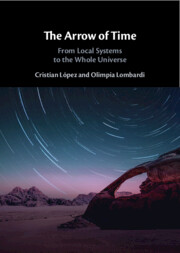Book contents
- The Arrow of Time
- The Arrow of Time
- Copyright page
- Contents
- Contributors
- Preface
- Acknowledgments
- Part I Local Systems
- 1 The Direction of Time: From the Cosmos to Local Systems
- 2 Thermodynamics with and without Irreversibility
- 3 Thermodynamics without Time
- Part II The Arrow of Time and Philosophical Issues
- Part III The Arrow of Time and Time-Reversal Invariance
- Part IV The Whole Universe
- Index
- References
3 - Thermodynamics without Time
from Part I - Local Systems
Published online by Cambridge University Press: 28 October 2025
- The Arrow of Time
- The Arrow of Time
- Copyright page
- Contents
- Contributors
- Preface
- Acknowledgments
- Part I Local Systems
- 1 The Direction of Time: From the Cosmos to Local Systems
- 2 Thermodynamics with and without Irreversibility
- 3 Thermodynamics without Time
- Part II The Arrow of Time and Philosophical Issues
- Part III The Arrow of Time and Time-Reversal Invariance
- Part IV The Whole Universe
- Index
- References
Summary
Our fundamental theories, that is, the quantum theory and general relativity, are invariant under time reversal. Only when we treat systems from the point of view of thermodynamics, that is, averaging between many subsystem components, an arrow of time emerges. The relation between thermodynamic and the quantum theory has been fertile, deeply explored and still a source of new investigations. The relation between the quantum theory and gravity, while it has not yet brought an established theory of quantum gravity, has certainly sparked in-depth analysis and tentative new theories. On the other hand, the connection between gravity and thermodynamics is less investigated and more puzzling. I review a selection of results in covariant thermodynamics, such as the construction of a covariant notion of thermal equilibrium by considering tripartite systems. I discuss how such construction requires a relational take on thermodynamics, similar to what happens in the quantum theory and in gravity.
Information
- Type
- Chapter
- Information
- The Arrow of TimeFrom Local Systems to the Whole Universe, pp. 56 - 70Publisher: Cambridge University PressPrint publication year: 2025
References
Accessibility standard: WCAG 2.1 AA
Why this information is here
This section outlines the accessibility features of this content - including support for screen readers, full keyboard navigation and high-contrast display options. This may not be relevant for you.Accessibility Information
Content Navigation
Allows you to navigate directly to chapters, sections, or non‐text items through a linked table of contents, reducing the need for extensive scrolling.
Provides an interactive index, letting you go straight to where a term or subject appears in the text without manual searching.
Reading Order & Textual Equivalents
You will encounter all content (including footnotes, captions, etc.) in a clear, sequential flow, making it easier to follow with assistive tools like screen readers.
You get concise descriptions (for images, charts, or media clips), ensuring you do not miss crucial information when visual or audio elements are not accessible.
Visual Accessibility
You will still understand key ideas or prompts without relying solely on colour, which is especially helpful if you have colour vision deficiencies.
Structural and Technical Features
You gain clarity from ARIA (Accessible Rich Internet Applications) roles and attributes, as they help assistive technologies interpret how each part of the content functions.
